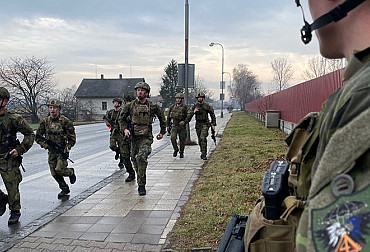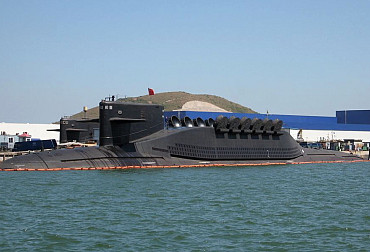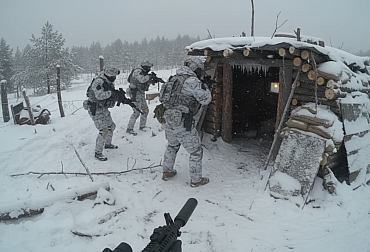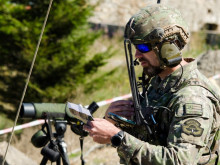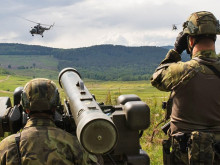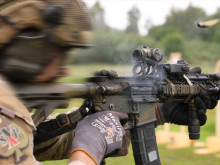The shutdown did not diminish the intensity of flight training at LOM PRAHA
The training of pilots of the Czech Army on helicopters has been moved from the home airport in Pardubice to the airport in Přerov-Bochor since mid-March. The reason for moving the helicopter equipment is the closure of Pardubice airport to all air traffic due to planned repairs of the main runway and taxiway. Training on subsonic L-39C Albatros and Z-142CAF aircraft was then moved to the 21st Tactical Air Force Base in Čáslav. In this context, the question arises whether, in times of high demand for flight training and the associated search for suitable airfields, the time has not come for the Czech Army to make wider use of the Přerov airport. Already last year, the Přerov airport was mentioned in connection with the operation of the 533rd Unmanned Aerial Vehicle Battalion, which is currently based in Prostějov.
Video: Report from the CLV visit in Přerov / CZ DEFENCE
The former military airport Přerov-Bochor has had the status of a national public and international non-public airport since 1 October 2013. Since 1 January 2014, the owner of the site is LOM PRAHA s.p., which has been granted permission by the CAA to operate a civilian international non-public and national public airport. A great added value of the site is the concrete runway, which is 2,500 metres long and 60 metres wide. Its strategic location also allows the development of civil transport. It is linked to the logistics centre in Přerov and the industrial zone in Holešov. However, the airport's greatest benefit is as a strategic area for military aviation and training purposes. The extensive area of the airport complex allows, if necessary, the construction of the necessary infrastructure for both the military and civilian sectors. According to Tomas Kalafus, radio controller at the airport control tower, the airport is currently busy for the public from 1 April to 31 October. The airport is currently at 80% capacity during this period on weekends, when the area is used by private operators of small aircraft and helicopters. In spite of all the existing limits imposed by the airport's facilities, aircraft up to a wingspan of 24 metres can land here: 'Plus, the operation of aircraft or critical types of aircraft used by the Czech Army, which is CASA, C-290 KM and ATR 72, is approved. There were also C-130 Hercules and An-124 Ruslan aircraft here," the controller said.
 Picture: View from the control tower of the Přerov airport | Michal Pivoňka / CZ DEFENCE
Picture: View from the control tower of the Přerov airport | Michal Pivoňka / CZ DEFENCE
However, the airport is mostly used by the Centre of Flight Training (CLV) of the state enterprise LOM PRAHA, which provides training for helicopter pilots. That is why we asked the director of the centre and long-time military helicopter pilot Ing. Jaroslav Špaček, a long-time helicopter pilot, asked what is the composition of students at the CLV. They come to us in the second year, and now for the third time also those who want to become helicopter pilots, they start directly on Enstrom 480 helicopters. The remaining ones go through training on the Z-142 and then are divided into tactical pilots (after completing training on the Z-142, they continue on the L-39) and transport pilots (who similarly continue on the L-410), some of whom are also earmarked to fly helicopters. In addition, we train pilots who have already completed their university education and have a civil aviation rating on En-480 helicopters. These are the so-called recruits and after completing the En-480 flying course they go to bases in both Prague-Kbely and Náměšt' nad Oslavou. Finally, pilots destined for the H-1 system come to fly with us, and after flying, for example, the Mi-24, they get acquainted with the "glass cockpit" and flying on a ski landing gear. It is not a secret that American helicopters differ from Russian ones in the direction of rotation of the nose rotor, which also entails certain changes in the control of the helicopter," says Jaroslav Špaček. As far as the number of pilots is concerned, according to Director Špaček, the requirements of the Czech Army are exactly fulfilled.
 Picture: Helicopter pilots training at CLV include flying Mi-17s (pictured) and American Enstrom 480 training helicopters | Michal Pivoňka / CZ DEFENCE
Picture: Helicopter pilots training at CLV include flying Mi-17s (pictured) and American Enstrom 480 training helicopters | Michal Pivoňka / CZ DEFENCE
We were also interested in how the training structure is designed, which Jaroslav Špaček commented on as follows. As far as UNOB student pilots are concerned, they start with training in the equivalent of PPL(H) in the first year and then continue with further training up to a total of about 150 to 200 hours, in which instrument flying, group flying, field landings, tactical flying, night flying, including NVG flying and flying with suspensions are also covered. Pilots who already have experience with other types have individual flying plans set up according to their experience. Another interesting feature of CLV was the training of foreign pilots." The CVL director further added that currently the CLV does not train any foreign pilots, but the centre is able to offer such training, adding that in the past several dozen foreign pilots have been trained in the CLV Pardubice aircraft and helicopters of the state enterprise LOM PRAHA.
 Picture: Mi-17 helicopters (pictured) and American Enstrom 480 training helicopters are flown in CLV as part of helicopter pilot training | Michal Pivoňka / CZ DEFENCE
Picture: Mi-17 helicopters (pictured) and American Enstrom 480 training helicopters are flown in CLV as part of helicopter pilot training | Michal Pivoňka / CZ DEFENCE
 Picture: Mi-17 helicopters (pictured) and American Enstrom 480 training helicopters are flown in CLV as part of helicopter pilot training | Michal Pivoňka / CZ DEFENCE
Picture: Mi-17 helicopters (pictured) and American Enstrom 480 training helicopters are flown in CLV as part of helicopter pilot training | Michal Pivoňka / CZ DEFENCE
The turning point for every future helicopter pilot is the moment when the theoretical training ends and the first flight in the Enstrom 480 training helicopter takes place. Radek Mičulek, a helicopter inspector, has his own experience with this, and regularly takes such flights. According to him, it is interesting to watch people who have never flown in their lives and suddenly have to show all aspects of flying - piloting technique, communication, navigation. Just how they can cope with a completely new set of activities. And it is for this training that the Enstrom 480 light utility helicopter is best suited.
 Picture: The turning point for every future helicopter pilot is the moment when the theoretical training ends and the first flight in an Enstrom 480 training helicopter (pictured) takes place | Michal Pivoňka / CZ DEFENCE
Picture: The turning point for every future helicopter pilot is the moment when the theoretical training ends and the first flight in an Enstrom 480 training helicopter (pictured) takes place | Michal Pivoňka / CZ DEFENCE
According to Mičulek, the Enstrom is quite well equipped in terms of avionics, it is easy to see out of and is really comfortable in emergency situations such as autorotation, engine shutdown or night control shutdown. We were wondering if we can tell from the first flight who will be a really good combat pilot and who will not? "You can already tell who is going to be faster or slower with that experience. But the first flights are familiarization flights, the difference is not as visible as during further training," says instructor Radek Mičulek.
 Picture: Cockpit of the Enstrom 480 training helicopter | Michal Pivoňka / CZ DEFENCE
Picture: Cockpit of the Enstrom 480 training helicopter | Michal Pivoňka / CZ DEFENCE
We had the opportunity to talk about the impressions and feelings from the first flight with UNOB students directly during the training and preparation. One of the students, Corporal Ondřej Kovář, just returned from such a flight and we asked him about his first impressions of the flight. "The helicopter moves around a lot, you can feel the punches and gears and how the rotor spins. You try to take in the surroundings. It's hard to balance all the movements around you," recounts the first impressions of the young pilot, who believes the role of a flight instructor is crucial. He takes over or passes on the pilot's job during the flight, depending on how he sees the newcomer doing at the time. If we simplify it a lot, it works like driving school. Before a pilot sits in a real machine, he or she goes through training on a simulator at CLV in Pardubice. "There you learn the basics on the machine, temperatures, technical data, how the machine works," says Corporal Kovář.
We asked him whether the move of CLV training from Pardubice to Přerov is only a short-term solution and to what extent the training is actually conducted in Přerov. The director of the CLV Jaroslav Špaček answered these questions. Until recently we were flying at night with NVG night vision goggles. Now that the students of the University of Defence have arrived, we fly only during the day. We have just started with the youngest students. We've started what we call hang gliding, circuits, flights to the surrounding area to get to know the environment. With the older students, we're doing field landings, practicing low-altitude navigation, just doing everything except instrument flying. We're flying Mi-17 transports and American Enstrom 480 trainers." And are there any differences between the airports in Pardubice and Přerov? According to Director Špaček, both airports are equally suitable for helicopter flying.
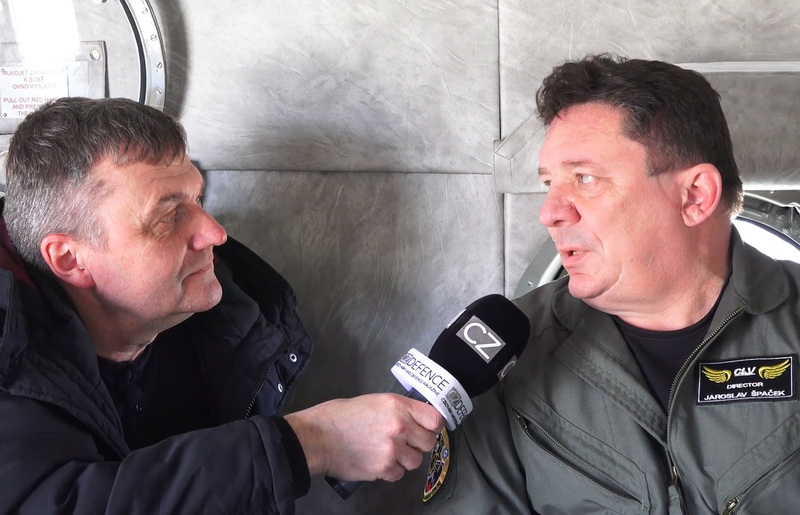 Picture: We asked CLV Director Jaroslav Špaček whether the move of CLV training from Pardubice to Přerov is only a short-term solution and to what extent the training is actually taking place in Přerov. | Jan Juřica / CZ DEFENCE
Picture: We asked CLV Director Jaroslav Špaček whether the move of CLV training from Pardubice to Přerov is only a short-term solution and to what extent the training is actually taking place in Přerov. | Jan Juřica / CZ DEFENCE
"The Přerov airport is fully suitable," says Director Špaček. The only thing this airport does not allow is flying in difficult weather conditions. And can the CLV director imagine that helicopter pilot training would be permanently relocated to Přerov? "The airport, as I said, is not suitable for flying in difficult weather conditions, which is a part of the training that we would have to do elsewhere. But certainly Přerov Airport has potential. It has all the equipment we need for flying day and night in normal conditions," adds CLV director Jaroslav Špaček.











